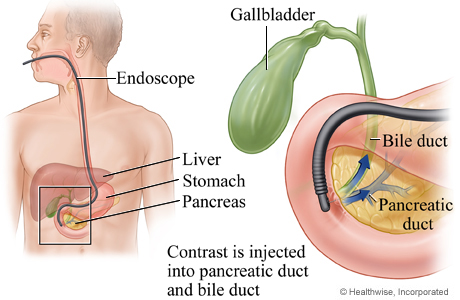Placement of Endoscope During ERCP
Current as of: November 7, 2018
Author: Healthwise Staff
Medical Review:E. Gregory Thompson, MD – Internal Medicine & Adam Husney, MD – Family Medicine & Jerome B. Simon, MD, FRCPC, FACP – Gastroenterology
An endoscopic retrograde cholangiopancreatogram (ERCP) is a test that combines the use of a flexible, lighted scope (endoscope) with X-ray pictures to examine the tubes that drain the liver, gallbladder, and pancreas. The endoscope is inserted through the mouth and gently moved down the throat into the esophagus…
Current as of: November 7, 2018
Author: Healthwise Staff
Medical Review:E. Gregory Thompson, MD - Internal Medicine & Adam Husney, MD - Family Medicine & Jerome B. Simon, MD, FRCPC, FACP - Gastroenterology
11/07/2018
This information does not replace the advice of a doctor. Healthwise, Incorporated, disclaims any warranty or liability for your use of this information. Your use of this information means that you agree to the Terms of Use. Learn how we develop our content.


An endoscopic retrograde cholangiopancreatogram (ERCP) is a test that combines the use of a flexible, lighted scope (endoscope) with X-ray pictures to examine the tubes that drain the liver, gallbladder, and pancreas.
The endoscope is inserted through the mouth and gently moved down the throat into the esophagus, stomach, and duodenum until it reaches the point where the ducts from the pancreas (pancreatic ducts) and gallbladder (bile ducts) drain into the duodenum.
ERCP can treat certain problems found during the test. If an abnormal growth is seen, an instrument can be inserted through the endoscope to obtain a sample of the tissue for further testing (biopsy). If a gallstone is present in the common bile duct, the doctor can sometimes remove the stone with instruments inserted through the endoscope. A narrowed bile duct can be opened by inserting a small wire-mesh or plastic tube (called a stent) through the endoscope and into the duct.
Current as of: November 7, 2018
Author: Healthwise Staff
Medical Review:E. Gregory Thompson, MD – Internal Medicine & Adam Husney, MD – Family Medicine & Jerome B. Simon, MD, FRCPC, FACP – Gastroenterology
This information does not replace the advice of a doctor. Healthwise, Incorporated, disclaims any warranty or liability for your use of this information. Your use of this information means that you agree to the Terms of Use. Learn how we develop our content.
Current as of: November 7, 2018
Author: Healthwise Staff
Medical Review:E. Gregory Thompson, MD - Internal Medicine & Adam Husney, MD - Family Medicine & Jerome B. Simon, MD, FRCPC, FACP - Gastroenterology
11/07/2018
This information does not replace the advice of a doctor. Healthwise, Incorporated, disclaims any warranty or liability for your use of this information. Your use of this information means that you agree to the Terms of Use. Learn how we develop our content.
